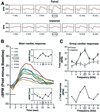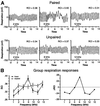Induction of behavioral associative memory by stimulation of the nucleus basalis
- PMID: 11904444
- PMCID: PMC122638
- DOI: 10.1073/pnas.062057099
Induction of behavioral associative memory by stimulation of the nucleus basalis
Abstract
The nucleus basalis (NB) has been implicated in memory formation indirectly, by lesions, pharmacological manipulations, and neural correlates of learning. Prior findings imply that engagement of the NB during learning promotes memory storage. We directly tested this NB-memory hypothesis by determining whether stimulation of the NB induces behavioral associative memory. Rats were trained either with paired tone (6 kHz) and NB stimulation or with the two stimuli unpaired. We later determined the specificity of cardiac and respiratory behavioral responses to the training tone and several other acoustic frequencies. Paired subjects exhibited frequency generalization gradients with a peak of 6 kHz for both cardiac and respiratory behavior. Unpaired subjects exhibited no generalization gradient. The development of such specific, associative behavioral responses indicates that tone paired with NB stimulation induced behavioral associative memory. The discovery of memory induction by direct activation of the NB supports the NB-memory hypothesis and provides a potentially powerful way to control and investigate neural mechanisms of memory.
Figures




Similar articles
-
Behavioral memory induced by stimulation of the nucleus basalis: effects of contingency reversal.Neurobiol Learn Mem. 2009 Mar;91(3):298-309. doi: 10.1016/j.nlm.2008.12.010. Epub 2009 Jan 23. Neurobiol Learn Mem. 2009. PMID: 19168141 Free PMC article.
-
Motivationally neutral stimulation of the nucleus basalis induces specific behavioral memory.Neurobiol Learn Mem. 2008 Jul;90(1):125-37. doi: 10.1016/j.nlm.2008.02.001. Epub 2008 Mar 17. Neurobiol Learn Mem. 2008. PMID: 18343695 Free PMC article.
-
Rapid induction of specific associative behavioral memory by stimulation of the nucleus basalis in the rat.Neurobiol Learn Mem. 2006 Jul;86(1):47-65. doi: 10.1016/j.nlm.2005.12.010. Epub 2006 Feb 8. Neurobiol Learn Mem. 2006. PMID: 16466937 Free PMC article.
-
The nucleus basalis and memory codes: auditory cortical plasticity and the induction of specific, associative behavioral memory.Neurobiol Learn Mem. 2003 Nov;80(3):268-84. doi: 10.1016/s1074-7427(03)00072-8. Neurobiol Learn Mem. 2003. PMID: 14521869 Review.
-
Auditory associative memory and representational plasticity in the primary auditory cortex.Hear Res. 2007 Jul;229(1-2):54-68. doi: 10.1016/j.heares.2007.01.004. Epub 2007 Jan 17. Hear Res. 2007. PMID: 17344002 Free PMC article. Review.
Cited by
-
Activation of the basolateral amygdala induces long-term enhancement of specific memory representations in the cerebral cortex.Neurobiol Learn Mem. 2013 Mar;101:8-18. doi: 10.1016/j.nlm.2012.12.013. Epub 2012 Dec 22. Neurobiol Learn Mem. 2013. PMID: 23266792 Free PMC article.
-
Behavioral memory induced by stimulation of the nucleus basalis: effects of contingency reversal.Neurobiol Learn Mem. 2009 Mar;91(3):298-309. doi: 10.1016/j.nlm.2008.12.010. Epub 2009 Jan 23. Neurobiol Learn Mem. 2009. PMID: 19168141 Free PMC article.
-
Sensory memory consolidation observed: increased specificity of detail over days.Neurobiol Learn Mem. 2009 Mar;91(3):273-86. doi: 10.1016/j.nlm.2008.10.012. Epub 2008 Dec 16. Neurobiol Learn Mem. 2009. PMID: 19038352 Free PMC article.
-
Intrinsic voltage dynamics govern the diversity of spontaneous firing profiles in basal forebrain noncholinergic neurons.J Neurophysiol. 2012 Jul;108(2):406-18. doi: 10.1152/jn.00642.2011. Epub 2012 Apr 11. J Neurophysiol. 2012. PMID: 22496531 Free PMC article.
-
Intermittent Stimulation of the Nucleus Basalis of Meynert Improves Working Memory in Adult Monkeys.Curr Biol. 2017 Sep 11;27(17):2640-2646.e4. doi: 10.1016/j.cub.2017.07.021. Epub 2017 Aug 17. Curr Biol. 2017. PMID: 28823679 Free PMC article.
References
-
- Iversen S D. Compt Rend Acad Sci Sci Vie. 1998;321:209–215. - PubMed
-
- Introini-Collison I B, McGaugh J L. Psychopharmacology. 1988;94:379–385. - PubMed
-
- Lehmann J, Nagy J I, Atmadia S, Fibiger H C. Neuroscience. 1980;5:1161–1174. - PubMed
-
- Mesulam M M, Mufson E J, Wainer B H, Levey A I. Neuroscience. 1983;10:1185–1201. - PubMed
-
- Casamenti F, Deffenu G, Abbamondi A L, Pepeu G. Brain Res Bull. 1986;16:689–695. - PubMed
Publication types
MeSH terms
Grants and funding
LinkOut - more resources
Full Text Sources
Other Literature Sources
Medical

